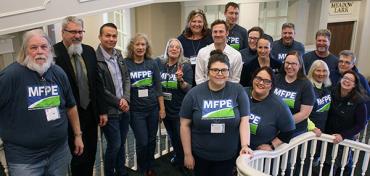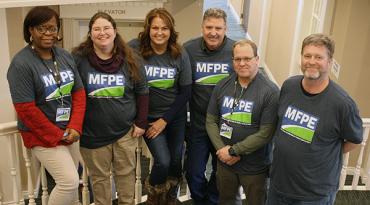A member mobilization campaign has produced significant steps in activism for the Montana Federation of Public Employees.
The campaign in Helena last month trained 36 members and staff—half from MFPE with help from the NEA, and half by AFT volunteers from around the country. The focus of the training was to re-familiarize members with MFPE after its historic merger last year, and to strengthen state employee membership. The Montana federation has about 1,500 state employee members in and around the state capital.
MFPE President Eric Feaver hailed the training by noting that engaging members through face-to-face conversations is the best way to build the union and silence naysayers. “Watch us, right here in Montana,” he says. “We are the future for those who work in our public institutions across our state and, someday, our nation.”
Six teams fanned out to members’ workplaces and homes for personal visits. During the six-day mobilization, MFPE’s teams of volunteers visited 40 work sites and knocked on 938 members’ doors over four evenings.
This was one of the most successful AFT mobilization trainings ever held, which union leaders attribute to established member organizer programs across the country, including those in AFT Connecticut, AFT Kansas and MFPE. Graduates from each of these programs were on hand. All participants—whether novices, veteran member organizers, team leaders or staff—sharpened their organizing skills.
It was the 15th member mobilization program organized by AFT Public Employees and the division’s first program held jointly with the NEA, which added new perspectives and skills.
Fellow AFT activists—from Alaska, Connecticut, Illinois, Kansas, Maryland and New York—volunteered with the teams. The volunteers returned to their states energized, engaged and educated to move their local unions to power.
As is customary after an AFT mobilization, the Montana federation agreed to an 18-month “after-care” plan of working with the AFT to get potential local leaders on board; continue member recruitment and engagement; make a strong transition into legislative advocacy and contract bargaining; and expand the federation’s member organizer program.
[Annette Licitra/MFPE photos]


